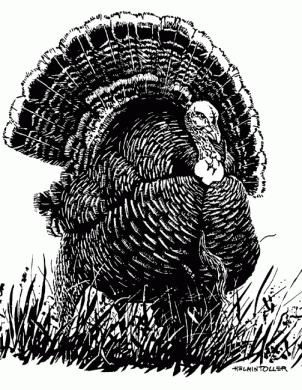By Carolyn McDonald Graf

One story goes that in 1526, a man from Yorkshire named William Strickland got two turkeys from an American Indian trader and sold them for tuppence each in Bristol. These are the first documented turkeys to be sold in the UK and Strickland proudly included an image of a turkey on his family crest. Although turkeys are native to the Americas, they were often imported into the UK on Turkish ships, giving the bird its English name.
Early references in Scottish recipes refer to a bubbly-jock. The term bubbly-jock dates from at least as early as the 1700’s. Earlier references from the Scottish Historical Review talk about a “twrkie” [1671] or “turkie cock” [1688]. A meal served in the presence of King James I while on his way to Scotland included roast turkey in 1617.
Turkey was not a popular bird at first, as they were considered difficult to raise. Other large birds, such as swans and peacocks, were the banquet birds of the wealthy, with geese and chickens for the lower classes. Henry VIII preferred turkey to birds of that period because it was tastier, exotic, and impressively larger. Gradually, with the improvements in transportation and farming methods, turkeys increased in popularity in Scotland and England.

Walnuts have a long and fascinating history and are considered the oldest of the tree fruits. Native to Asia, walnuts have been traced through archaeological records back to Persia in 7,000 BC, where they were found both in the wild and in a semi cultivated state. Historians think it was probably part of the hunter gathering tribe’s food in that area. It is thought that walnuts would have spread further in Europe had it not been for the last glacial epoch.
By the time there are written records in Persia, walnuts were permitted only to royalty. They were enjoyed as a delicacy and walnut flour was used to thicken soups and stews. The Persian name for walnut was “royal”. Clay tablets from the second century BC have inscriptions that show walnut trees were grown in the hanging gardens of Babylon.
In Greece walnuts were used in hair dyes, wool fabrics and medicine. The Romans also knew of walnuts. Pliny the Elder, in his Naturalis Historia Treatise, suggested that a paste of walnuts, chewed by a fasting man, could be applied to a wound made by a rabid dog to heal the wound. Many other medicinal uses of walnut juice were suggested to cure colic, diarrhea, and constipation. By the third century AD the Chinese believed that walnut milk was capable of giving strength and was a nutritious substitute for cow’s milk.
Walnuts gradually spread to Europe where, in the 14th century AD, the French preserved walnuts in a mixture of honey and spices, and served them at royal banquets. The English Merchant marines were instrumental in bringing walnuts to Northern Europe through their world trade. Walnuts kept in the shell lasted up to six months and were well suited to world trade. Although not grown in England, they became known as English Walnuts after the sailors that brought them.
The first mention of walnuts in the UK wasn’t until the middle of the 16th century, where they were served at the end of a meal with pork or Stilton cheese. During the 1700’s, the use of walnuts began to be seen more as a food than a medicine. Due to their ease of storage and transportation, they became cheaper and were no longer a food only for the wealthy.
Smothered Turkey with Walnuts

Dishes mixed with various foods were termed “smothered”. Walnuts were considered to bring good luck and good health in Gaelic lands and were thus included in festive dishes. This would be a wonderful winter dish on a cold night.
2 tablespoons melted butter
½ cup finely chopped onions
½ cup finely chopped celery
1 teaspoon curry powder
½ teaspoon paprika
1 cup stale coarse breadcrumbs
4 cups diced cooked turkey
½ cup turkey gravy
Salt, pepper
1 cup coarsely chopped walnuts
½ heavy cream (more if desired)
½ cup chopped parsley
Melt butter in a large skillet. Sauté onion and celery until soft. Stir in curry and paprika. Add breadcrumbs and sauté until brown. Add turkey and gravy. Season with salt and pepper. Cover and cook on low for about 10 minutes. Stir in walnuts, cream, and parsley. Cook stirring until heated through. Makes 4 to 6 servings.
https://www.gwct.org.uk/wildlife/species-of-the-month/2017/turkey/
https://www.nutstop.com/what-is-the-history-of-walnuts/
https://www.agricorti.it/en/origins-and-use-of-walnuts-throughout-history/
https://www.chandlerorchards.com/walnut-history/
The Scottish and Irish Pub Cookbook, Kay Shaw Nelson, 2003, Hippocrene Books, New York, NY p.114

